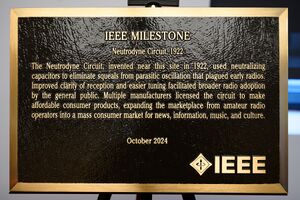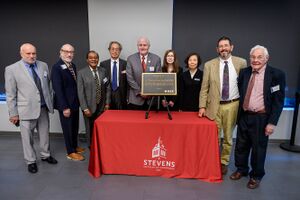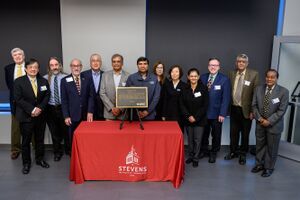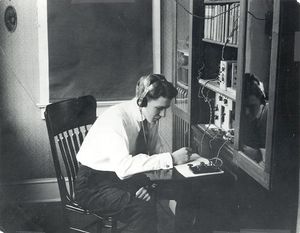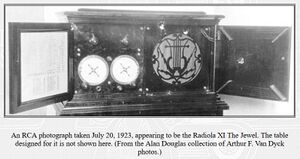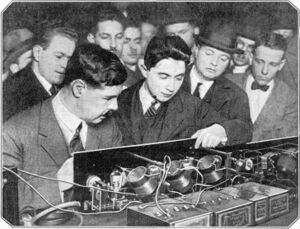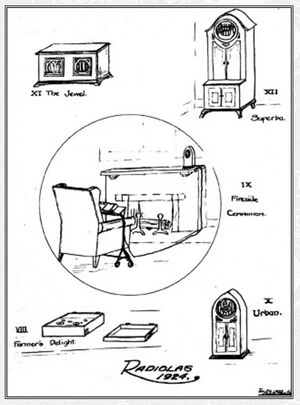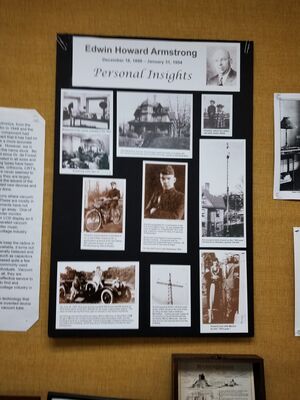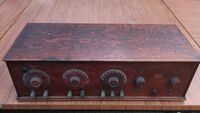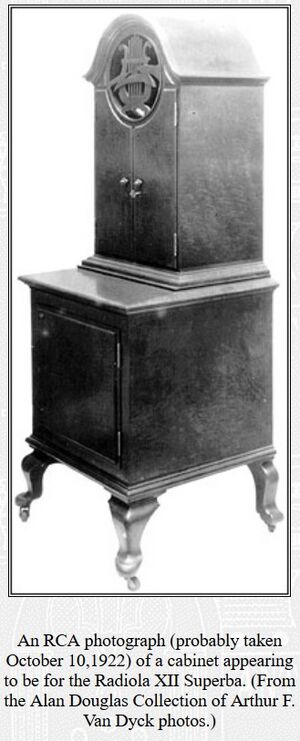Milestones:Neutrodyne Circuit, 1922
- Date Dedicated
- 2024/10/19
- Dedication #
- 259
- Location
- Hoboken, NJ
- IEEE Regions
- 1
- IEEE sections
- North Jersey
- Achievement date range
- 1922
Title
Neutrodyne Circuit, 1922
Citation
The Neutrodyne Circuit, invented near this site in 1922, used neutralizing capacitors to eliminate squeals from parasitic oscillation that plagued early radios. Improved clarity of reception and easier tuning facilitated broader radio adoption by the general public. Multiple manufacturers licensed the circuit to make affordable consumer products, expanding the marketplace from amateur radio operators into a mass consumer market for news, information, music, and culture.
Street address(es) and GPS coordinates of the Milestone Plaque Sites
The Edwin A. Stevens building, Stevens Institute of Technology, 5th Street between Hudson and River Sts, Hoboken, New Jersey, U.S.A. The building is listed on the New Jersey and the National Register of Historic Places. The plaque will be inside the front entrance of the building, which is only a few hundred meters from the location of the former laboratory where the Neutrodyne was invented., 40.742287, -74.027778
Details of the physical location of the plaque
The plaque will be mounted in the ground floor entrance hall.
How the plaque site is protected/secured
The building is open to the public weekdays between 9 A.M. and 9 P.M.
Historical significance of the work
The Neutrodyne Circuit invented on this site in 1922 in the Navy Building in the laboratory of Professor Louis Alan Hazeltine with Harold A. Wheeler and others, enabled affordably easier to tune radios and neutralized capacitors eliminating squeals from parasitic oscillation previously plaguing radio receivers and amplifiers. These improvements in performance and simplicity rapidly expanded radio use from amateur radio operators to usher in a mass communication consumer market. In 1923, 500 stations were broadcasting to about two million listeners; Neutrodyne was licensed to 20 manufacturers, expanded ownership by 10 million affordable radios, an increase from 10 to 60% of the population of North America and impact on how individuals receive information, music and culture – transforming opportunities for everyone – with enduring effects evident in our everyday lives. Many have noted the inspiration of Professor Armstrong and his more expensive RCA solutions; what is important to note about this 'inspiration' and the unique Neutrodyne solution, is that the Neutrodyne team sought specifically to Democratize access to Technology which serves Humanity. Radio Democratized Politics and so many other opportunities. The Neutrodyne team quickly provided licenses to 20 companies rather than to create a complex expensive solution as RCA chose to do. Armstrong's super heterodyne and regenerative circuits solution for RCA was kept proprietary and expensive, which created disparity between wealthy and everybody else. Because of Neutrodyne, in 1923 and 1924 the entire product line proposed by RCA was halted (proposed product catalog included in references) and the Chicago Radio Show offered many new more affordable products creating opportunities for businesses, broadcasters, stimulating commerce, consumers, regular people for the very first time. In this way for the first time, regular people all over North America had access to Politics of the day, became educated about many things, heard music, entertainment, learned about the latest news, etc. Previously, only 10 percent of the population had access. With Neutrodyne, in three years, 60 percent had access. Mass communication. Not just for the wealthy. Regular people could learn and hear politics of their day and engage in the culture of their time in a meaningful way. This was a major transformative influence on society lasting to the present time. In the autumn of 1922, Prof Alan Hazeltine designed a receiver using a Tuned Radio Frequency amplifier. Joseph Freed of the Freed-Eisemann Radio Corp. built the first model from plans supplied by Hazeltine. Hazeltine demonstrated the receiver on 2 March 1923 at a meeting of the Radio Club of America at Columbia University, New York City. Patent US1450080 issued to Hazeltine on 27 March 1923, and Hazeltine Corporation stock began trading on 1 February 1924 on the Curb Exchange (now the AMEX).
The Neutrodyne was a circuit with an extra capacitor and two coils, which could completely stabilize a radio frequency amplifier. The circuit was usually designed with three tuned circuits and three dials, including two stages of radio frequency (RF) amplification and a tuned detector. Since a nonregenerative detector was used, the circuit was free of patent infringement.
To reduce magnetic coupling between the tuning coils, the three coils were assembled at a critical angle, mathematically derived by Hazeltine as 54.7 degrees. The three dials and the coils at this angle identified a 'Neutrodyne' receiver. The first sets were produced by Freed-Eisemann Radio Corporation in 1923, and soon there were a number of licensees paying royalties to Hazeltine. He founded a research and consulting service, and was President of the IRE (Institute of Radio Engineers) in 1936 -- John Ryder and Donald Fink, Engineers & Electrons, 1984, IEEE Press, p 76
Detail of receiver with Hazeltine stamp
Detail of receiver showing Dials
Features that set this work apart from similar achievements
Prior to the invention of the Neutrodyne Circuit, radio receivers were extremely difficult to tune. This was due to an amplifier placed before the regenerative detector circuit which, when tuned incorrectly, would begin to oscillate and produce receiver “squeals”. The “Super Heterodyne” solved this problem, but RCA’s monopoly on the solution made implementing the technology prohibitively expensive for most amateur radio operators.
Unlike most radio receivers of the day, the Neutrodyne Circuit utilized an extra capacitor and two coils. Unlike the Super Heterodyne, the Neutrodyne leveraged a nonregenerative detector, so it did not infringe on RCA’s intellectual property. Additionally, to reduce magnetic coupling between the two capacitors, the capacitors in a Neutrodyne are placed at 54.7 degree angles. These distinct features produced radio receivers that could be easily tuned and did not require extensive training to operate.
Hazeltine then licensed this technology to 20 different radio manufacturers. This meant that Neutrodyne receivers could be mass produced and sold at a price that was accessible to the average American. Due to the ease of operation and affordable price of Neutrodyne receivers, consumer radio ownership grew from 10% of Americans in 1923 to 60% in 1927. This unique combination meant the Neutrodyne circuit brought radio technology to the masses.
Dedication Ceremony Program
Significant references
- Hazeltine, L. A., "Tuned Radio-Frequency Amplification with Neutralization of Capacity Coupling," (a paper presented before the Radio Club of America), QST, 2 March 1923
- Dreyer, J. F., "How to Build a Neutrodyne Set," Popular Science Monthly, March 1924, pp 73, 1546-149
- Dodds, Lawrence B., "Louis Hazeltine--A Human Professor," Stevens Indicator, Fall 1979/Winter1980 pg 19.
- Hazeltine Corporation v. AH Grebe & Co. 21 F.2d643 (E.D.N.Y. 1927)
- Hazeltine Corporation v. Radio Corporation of America, 42 F.2d 504 (S.D.N.Y.)
- Molnar, Mike, "Hazeltine, the Neutrodyne, and the Hazeltine Corporation," Antique Wireless Association Review, 2013, Vol. 26 (a copy of this article is on file at the History Center for reference by the proposers and the advocate)
- Ryder, John and Fink, Donald, Engineers & Electrons, 1984 IEEE Press, pg 76.
- US1450080 Hazeltine's Neutrodyne Patent issued 27 March 1923
- Wheeler, Harold A. Hazeltine the Professor, 1978, Greenlawn, N.Y.
- Wheeler, Harold Alden, The Early Days of Wheeler and Hazeltine Corporation -- Profiles in Radio and Electronics," 1982, Greenlawn, N.Y.
Supporting materials
- "Speeches Must Be Short: Radio and the Birth of the Modern Presidential Campaign", Pacific Standard, Oct 2 2012
- National Radio Institute - The Neutrodyne Receiver
- Hazeltine, L. A., "The Neutrodyne Receiver", 1923 The Stute
- Ryder, John and Fink, Donald, Engineers & Electrons, 1984 IEEE Press, pg 76.
- Biography of Alan Hazeltine
- IEEE Showcase - Futurecast - Neutrodyne Milestone Video
- "RCA's Intended Models for the 1923-1924 Season "What Might Have Been", Antique Radio Classified, June 1999
